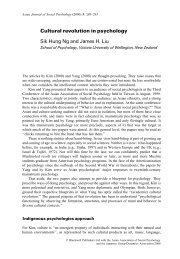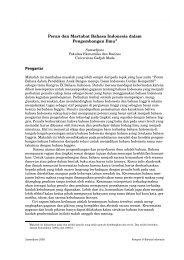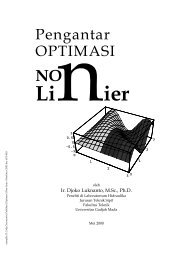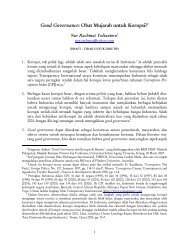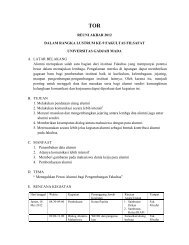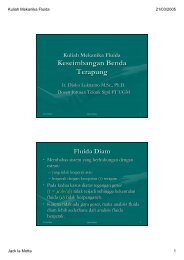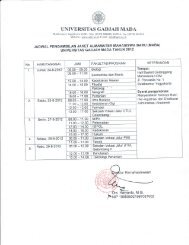Estimating the Codifference Function of Linear Time Series Models ...
Estimating the Codifference Function of Linear Time Series Models ...
Estimating the Codifference Function of Linear Time Series Models ...
Create successful ePaper yourself
Turn your PDF publications into a flip-book with our unique Google optimized e-Paper software.
that <strong>the</strong> codifference function τ(k) <strong>of</strong> <strong>the</strong> linear process (1) is <strong>of</strong> <strong>the</strong> form (see Kokoszka and Taqqu<br />
(1994))<br />
⎡<br />
⎤<br />
∞∑<br />
τ(k) = σ α |s| α ⎣ (|(c j+k − c j )| α − |c j+k | α − |−c j | α ) ⎦,k ≥ 0 (6)<br />
j=0<br />
Note that under conditions C1 and C2, <strong>the</strong> normalized codifference function (5) is independent<br />
with <strong>the</strong> choice <strong>of</strong> s (i.e., for given α, it is equal to I(1, −1; k) = τ(1, −1; k)/τ(−1, 1; 0) for any<br />
choice <strong>of</strong> s). For SαS process, τ(1, −1; k) is coincided with <strong>the</strong> codifference function u(k) as given<br />
in Samorodnitsky and Taqqu (1994), eq. (4.7.1). For given strictly stationary SαS process X t ,<br />
u(k) is defined as<br />
u(k) = 2(σ Xt ) α − (σ Xt+k −X t<br />
) α (7)<br />
where σ Z and σ Y −Z denote <strong>the</strong> scale parameters <strong>of</strong> Z and Y − Z, respectively.<br />
Notice that if <strong>the</strong> SαS stationary process X t is independent, <strong>the</strong>n for k ≠ 0, u(k) = 0, and<br />
clearly, τ(k) = 0 for all s. Conversely, if u(k) = 0, k ≠ 0 and 0 < α < 1, <strong>the</strong>n X t independent.<br />
When 1 ≤ α < 2, u(k) = 0 does not imply that X t+k and X t are independent (Samorodnitsky<br />
and Taqqu, 1994).<br />
Using Property 2.10.5 in Samorodnitsky and Taqqu (1994), we obtain that <strong>the</strong> normalized<br />
codifference I(k) has <strong>the</strong> following property<br />
0 ≤ I(k) ≤ 1 if 0 < α ≤ 1 (8)<br />
1 − 2 α−1 ≤ I(k) ≤ 1 if 1 ≤ α ≤ 2 (9)<br />
When α = 2, (9) is equal to −1 ≤ ρ(k) ≤ 1, where ρ(·) denotes <strong>the</strong> autocorrelation function.<br />
Fur<strong>the</strong>r <strong>the</strong>oretical properties <strong>of</strong> <strong>the</strong> codifference function were studied in Kokoszka and Taqqu<br />
(1994), Samorodnitsky and Taqqu (1994), Nowicka (1997) and Nowicka and Weron (1997).<br />
As <strong>the</strong> codifference function is defined via characteristic functions (cf ), it can be estimated by<br />
empirical characteristic functions (ecf )(see, e.g., Yu, 2004, for a review on ecf ). Given a sample<br />
X 1 , X 2 , . . . , X N , an estimator for <strong>the</strong> codifference function at lag k ∈ Z can be defined as (s ∈ R)<br />
ˆτ(s, −s; k) = √ (N − k)/N × [− lnφ(s, −s; k) + lnφ(s, 0; k) + lnφ(0, −s; k)] (10)<br />
where for u, v ∈ R<br />
φ(u, v; k) =<br />
{<br />
(N − k) −1 ∑ N−k<br />
t=1 exp(i(uX t+k + vX t )) when k ≥ 0<br />
(N + k) −1 ∑ N+k<br />
t=1 exp(i(uX t−k + vX t )) when k < 0<br />
(11)<br />
ˆτ(s,−s;k)<br />
Accordingly, Î(s, −s; k) =<br />
ˆτ(s,−s;0)<br />
can be used as <strong>the</strong> estimator <strong>of</strong> <strong>the</strong> normalized codifference<br />
I(k). Here we consider a discrete estimation procedure, i.e., we evaluate <strong>the</strong> codifference function<br />
at r points s 1 < · · · < s r , for s i ∈ R, s i ≠ 0, i = 1, . . .,r. In what follows, we denote <strong>the</strong> vectors<br />
s = {s 1 , . . . , s r },<br />
ˆτ(s, k) = [ˆτ(s 1 , −s 1 ; k), ˆτ(s 2 , −s 2 ; k), . . . , ˆτ(s r , −s r ; k)] T<br />
and<br />
Î(s, k) = [Î(s 1, −s 1 ; k), Î(s 2, −s 2 ; k), . . . , Î(s r, −s r ; k)] T<br />
Note that one can replace <strong>the</strong> factor √ (N − k)/N in (10) by unity, and also <strong>the</strong> divisor (N − k)<br />
in (11) by N without changing <strong>the</strong> asymptotic properties <strong>of</strong> <strong>the</strong> estimator, however, <strong>the</strong> choices<br />
in (10) and (11) will give a better finite sample performance than <strong>the</strong> alternative. Note that<br />
ˆτ(−k) = ˆτ(k) such one can restrict <strong>the</strong> analysis to <strong>the</strong> case <strong>of</strong> k ≥ 0. Two similar estimators for<br />
<strong>the</strong> codifference function have recently been proposed in Yang et al. (2001) and in Hong (1999).<br />
3



